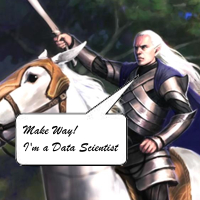The role of the data scientist has become more frequently discussed and probed as data analysis tools and techniques continue to grow in popularity.
There are numerous descriptions available as to what the role comprises. But essentially a data scientist not only gathers and reports on data but also analyzes a variety of different data streams from multiple perspectives, spot trends and/or recommends ways to apply data.
 Data scientists should have a good foundational understanding of the business and its needs. She should also have the ability to effectively communicate data analysis and data discovery findings in a way that both business and IT leaders can understand.
Data scientists should have a good foundational understanding of the business and its needs. She should also have the ability to effectively communicate data analysis and data discovery findings in a way that both business and IT leaders can understand.
Despite the value that a data scientist can bring to the table, the question remains within many organizations: does every business need a data scientist?
Shawn Rogers (@shawnrog) raises some valid points on the topic in a video interview with SearchBusinessAnalytics. According to Rogers, the need for a data scientist depends, in part, on the organization in question and the amount of data that’s available to be analyzed.
Data scientists “need a deep pool to swim in,” says Rogers. If you only have a sandbox worth of data to work with, a data scientist isn’t going to be able to find a lot of interesting insights, Rogers adds.
Small business leaders who may have a smaller pool of data to work with may not feel it’s logical to hire a data scientist, especially if they face capital and other resource constraints. Still, a company that invests in one or more data scientists positions itself to identify emerging market trends and business opportunities ahead of the competition, thus providing itself with a competitive edge and what will likely be a strong return on investment.
For larger organizations – or even smaller ones that are experiencing steady growth – a data scientist can add tremendous business value.
Thomas H. Davenport and D.J. Patil offer a great example of this in a recent Harvard Business Review article. The authors point to Jonathan Goldman, a Ph.D. in physics from Stanford University, who started working at LinkedIn in 2006.
To Goldman, the company still felt like a start-up even though it had just under eight million accounts – a number that was rapidly increasing as existing members invited their friends and colleagues to join. The problem was the users didn’t seem to be seeking out connections with the people who were already on the site at the rate LinkedIn executives had expected.
So Goldman began applying data analysis to people’s network connections to help the company develop a better idea of which people were likely to connect with others. Company execs could also use data analysis techniques to explore what might occur by presenting people with the profiles of others they’d not yet connected with but were likely to know based on their backgrounds.
Goldman did this by creating a custom ad that displayed the three best potential matches for each user based on the background information entered in that user’s profile. The result: the click-through rates on those ads were the highest that LinkedIn had seen to that point, according to the authors of the HBR article.
Goldman continued to refine the suggestions that were generated. LinkedIn’s managers began to see the opportunity before them and made the ads a standard feature. LinkedIn’s “People You May Know” ads generated millions of page views and the company’s growth took off.
Of course, it helped Goldman tremendously to have an analytics champion in LinkedIn co-founder Reid Hoffman, who gave Goldman a great deal of autonomy in his work, according to Davenport and Patil.
But the example nevertheless demonstrates the kind of business value that data scientists can bring to an organization.





